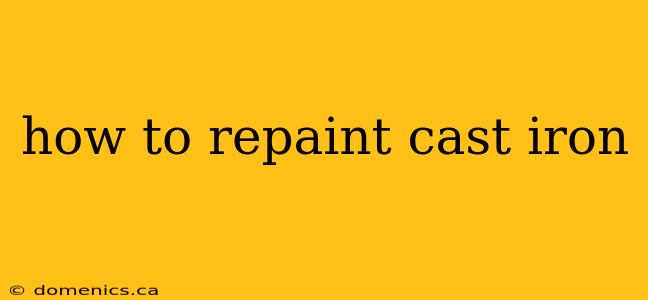Cast iron, with its durability and rustic charm, is a popular choice for everything from cookware to outdoor furniture. But over time, even the toughest cast iron can show its age. Whether it's chipped paint, rust, or simply a desire for a fresh look, repainting cast iron is a manageable project that can restore its beauty and extend its life. This comprehensive guide will walk you through the process, step by step.
Preparing Your Cast Iron for Repainting
Before you even think about grabbing a paintbrush, proper preparation is crucial for a long-lasting, beautiful finish. This stage is the most important part of the process. Neglecting it will result in peeling paint and a disappointing outcome.
1. Cleaning the Surface: The Foundation of a Good Paint Job
Thoroughly clean your cast iron piece. Use warm, soapy water and a stiff brush to remove dirt, grease, and grime. For stubborn residue, consider using a degreaser. Let it dry completely before proceeding.
2. Removing Old Paint and Rust: Stripping to the Metal
Existing paint must be removed to ensure the new paint adheres properly. For small areas or delicate pieces, a wire brush might suffice. For larger pieces or heavily painted surfaces, consider chemical paint strippers. Always follow the manufacturer's instructions carefully, as these chemicals can be harsh. After stripping, use a wire brush to remove any remaining paint or rust.
Pro Tip: Wear gloves and eye protection when using chemical strippers. Work in a well-ventilated area.
3. Addressing Rust: Eradicating the Enemy
Rust is the cast iron's worst enemy. If you find rust, remove it completely using a wire brush or a rust converter. A wire brush will remove surface rust, but a rust converter chemically neutralizes it, preventing further corrosion. This is especially important for outdoor furniture.
4. Sanding for a Smooth Finish: The Key to Adhesion
After removing old paint and rust, sand the surface smooth using sandpaper (start with a coarser grit and move to finer grits). This creates a better surface for the primer to adhere to, preventing peeling. Wipe away all sanding dust with a tack cloth.
Priming Your Cast Iron: The Unsung Hero
Priming is a critical step often overlooked. Primer acts as a barrier between the metal and the topcoat, preventing rust and promoting paint adhesion.
Choosing the Right Primer: A Crucial Decision
Use a metal primer specifically designed for cast iron. This type of primer will provide superior adhesion and corrosion resistance. Oil-based primers tend to offer better protection against rust, while water-based primers are easier to clean up.
Applying the Primer: Even Coverage is Key
Apply the primer evenly using a brush or spray can. Follow the manufacturer's instructions regarding drying time. Multiple thin coats are better than one thick coat. Allow ample drying time between coats.
Painting Your Cast Iron: The Finishing Touch
Finally, it's time to apply the topcoat! Choose a paint suitable for outdoor use if the piece will be exposed to the elements.
Selecting the Right Paint: Durability and Aesthetics
Choose a high-quality paint that's durable and resistant to chipping and fading. For outdoor use, consider an enamel or acrylic-alkyd paint. For indoor use, a high-quality acrylic latex paint will work well.
Applying the Paint: Techniques for a Smooth Finish
Apply the paint evenly using a brush, roller, or spray can. Multiple thin coats are better than one thick coat. Allow ample drying time between coats. Consider using a high-quality paintbrush for a smoother finish.
Protecting Your Finished Piece: Sealing in the Beauty
Once the paint is fully dry, consider applying a clear coat sealant to protect the paint job and extend its lifespan. This is especially important for outdoor pieces.
Maintaining Your Repainted Cast Iron: Long-Term Care
With proper care, your repainted cast iron can last for years to come. Regularly clean your piece and touch up any chips or scratches promptly. This will prevent rust and keep it looking its best.
Frequently Asked Questions (FAQs)
Q: What type of paint is best for repainting cast iron cookware?
A: For cookware, use a high-heat paint specifically designed for use on cookware. These paints can withstand high temperatures. Avoid using regular paints, which can release harmful fumes when heated.
Q: How long should I let the paint dry between coats?
A: Allow each coat to dry completely before applying the next. This drying time depends on the type of paint and environmental conditions. Always refer to the manufacturer's instructions.
Q: Can I use spray paint for repainting cast iron?
A: Yes, you can use spray paint, but ensure it's designed for metal and outdoor use (if applicable). Multiple thin coats are essential to avoid runs and drips. A spray paint provides a smoother finish.
Q: How do I prevent rust after repainting?
A: Thorough surface preparation, the use of rust converter (if needed), a high-quality metal primer, and a durable topcoat are essential in preventing rust. A clear coat sealant adds an extra layer of protection.
By following these steps, you can successfully repaint your cast iron, giving it a fresh new look and extending its life for years to come. Remember, patience and careful preparation are key to achieving a professional-looking finish.
